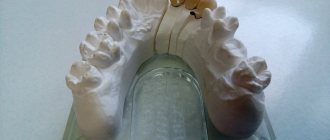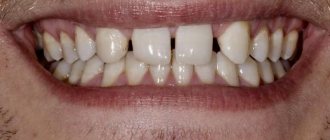Orthodontic treatment does not end when braces are removed. To maintain the results obtained by keeping the teeth in the correct position, patients have to wear a so-called retainer for some time. Today, there are various options for retention structures of removable and non-removable types, but due to the successful combination of functionality and cost, the most popular is the non-removable wire type. It is miniature in size and is attached to the lingual side of the teeth, remaining invisible to others. The type of retainer is chosen by the attending physician, depending on the clinical situation and the pathology of the bite.
Types of devices: which ones break down and come off more often
Several types of retention devices are used in orthodontic practice. Conventionally, they can be divided into removable [1] and those that cannot be removed from the mouth independently.
Removable devices
Removable types are represented by special aligners (not to be confused with aligners that straighten the dentition!). The cost of such mouthguards is low, about 3000-5000 rubles. They complete treatment in situations where it is impossible to install a permanent retainer. In some clinical cases (we will definitely consider them further), they can also act as an additional measure, and then they are used in conjunction with non-removable systems.
On a note! Rarely, removable devices such as trainers, plates and face bows are used as an auxiliary measure during the retention period. Typically, the need for their use arises when there are bite pathologies that need correction. For example, trainers are used for functional disorders and in order to form correct muscle memory.
The mouthguards are very aesthetic and easy to use. They are easy to clean and can be removed from the mouth when eating and brushing teeth. But not everyone likes the fact that the time the devices are in the mouth constantly has to be monitored. You must not forget to install mouth guards, for example, at night, and this requires a high level of self-control from patients, otherwise the entire result can quickly fade away.
You need to understand that such products simply cannot come off, since no one glues them to the teeth. The risk of their breakage is also low.
Fixed structures
In most cases, treatment results are consolidated using the second group of devices, which are non-removable. These are the ones that are fixed to the teeth using special glue and filling material.
The structures consist of stainless metal wire or other rigid material (fiberglass and nylon thread). They are fixed in pre-created grooves or recesses on the inner (lingual) side of the row. Or they are simply glued to the inner surface of the teeth (today this option is used more often).
Non-removable retainers are lightweight, compact, aesthetic, do not cause discomfort and do not interfere with the beauty of your smile, and are designed for a long period of use. That is why they are installed on a large number of patients. True, you have to get used to it, because... in the first few days the structure will interfere with the tongue.
Important! A non-removable retainer accompanies the patient while eating, brushing teeth, talking, sleeping; hygienic care of the oral cavity is difficult in it, so situations often occur when it comes off, falls off or bends.
How to react
If you are sure or at least suspect that some part of the wire has come off, you need to schedule a visit to the doctor as soon as possible. There is no need to panic if this happens in the evening or on the weekend when the patient is out of town. It is important to remember that fatal consequences will not occur in three to four days. If a person is in another city and cannot return in a few days to consult with his doctor, he needs to contact another orthodontist, and after returning, be sure to go to his specialist.
In order to alleviate the condition of irritated mucous membranes, it is recommended to use orthodontic wax. It is heated in your hands until it becomes elastic and attached to the problem area.
It is strictly forbidden to try to tear off the piece that has come off. Such actions can lead to breakage of the retainer, breakage of the tooth or adjacent elements in the dentition. Sometimes such attempts lead to serious injuries to the soft tissues in the oral cavity.
Wire peeling off occurs quite often in orthodontic practice, so it should be remembered that the key to success is a quick response. This problem cannot be ignored, since a violation of the structure of the retainer will lead to retrograde movement of the dentition, and this will cause the loss of the results of treatment with braces.
Features of installing fixed systems
As a rule, fixed appliances are installed in the area of the front teeth. They capture the six anterior elements of the row (all incisors and canines), less often - only four incisors, but in this case they are complemented by a removable mouth guard, which we discussed above. This measure prevents the teeth from returning to their original position.
Fixed appliances are very rarely installed on molars and premolars due to the anatomical features of these teeth and the complexity of fixation. The only exceptions are those cases when the first and second premolars are removed during orthodontic treatment - then the structures are fixed in order to avoid the formation of cracks and spaces between units of the row.
The cause of the failure is a relapse of orthodontic treatment.
If, during treatment with braces, the doctor was unable to completely eliminate the cause that caused the anomaly in the dental system, it will sooner or later become more active and cause malocclusion. The process will start again, only this time the chewing load will increase not only on some teeth, but also on the retention apparatus that stabilizes them in the correct position. In this case, it is impossible to avoid peeling off or breaking the wire tire, no matter what its diameter.
In this case, it is necessary to conduct a thorough analysis of the correction performed, identify any mistakes made, and, unfortunately, repeat the orthodontic treatment.
| Retention devices The wonderful moment of the appearance of a gorgeous smile after wearing braces must be secured. For this purpose, professionals use a special device - a retention device, or retainer. It is needed so that the results from bite correction stay with you for life. Smile Studio specialists take care to achieve the maximum effect from their work and always include the retention stage in the course of treatment. | 6 000 ₽ |
How are permanent retainers installed?
Immediately before installing the systems, the specialist refers the patient to professional teeth cleaning, where all types of plaque are removed. Then an x-ray is taken to determine the position of the roots. And the installation process itself looks like this:
- the doctor creates small depressions or grooves on the inside of the dentition (if necessary),
- polishes the lingual surface (from the side of the tongue) and applies an etching gel to it,
- the tissues are thoroughly dried, treated with an adhesive composition, after which the retention wire is positioned,
- the wire is covered with a composite material on top,
- The composite is polymerized with a lamp, carefully ground and polished.
Removable retainers
This type of retainer can be characterized as follows:
1. During use, they are removed for a while, but the option of continuous wearing is not excluded - this is determined by the orthodontist in each individual case.
2. It is possible to use the device only at night or only during the day, and also allows patients to remove the retainer while brushing their teeth or eating.
3. The material for the manufacture of removable retainers is usually plastic polymer and metal wire. Transparent products almost always remain unnoticeable to others. Taking into account the fact that only a very thin layer of plastic is used, such retainers do not bring any inconvenience to their owner.
4. Designs are divided into single-jaw, which are worn constantly or put on for a specific period, and two-jaw, for short-term wear.
5. The disadvantages of removable retainers are that their use can cause allergic reactions. They will also need to be cleaned frequently.
Reasons leading to non-removable appliances peeling off
Let's look at the main reasons why the retainer comes off.
Medical errors
Doctors themselves are often involved in the fact that the retainer comes off because they did not properly treat hard tissues before the procedure and after gluing the device. Placement of a fixed system is a very delicate job that requires accuracy and precision from the orthodontist[2].
If you make a mistake at one of the stages (poorly polish, dry and clean hard tissues, do not completely remove saliva and tissue fluid, install the system in the wrong place, apply filling material poorly), then a situation where the retainer, its edge or tip has completely peeled off - it's only a matter of time.
Important! If the structure is initially installed incorrectly, then it will bear a serious load, which will lead to the retainer breaking or bending.
The doctor’s mistake may consist not only in the violation of the technique of preparing the dentition for the installation of devices and in the incorrect positioning of the structures, but also in the fact that the specialist began the retention period ahead of time, that is, at the stage when occlusion pathologies are not completely eliminated.
Negligent attitude of the patient to the recommendations of the orthodontist
Situations where the tip of the retainer or its edge have come off often arise because the patient does not follow the prescribed diet or eats too hard and sticky foods.
Excessive zeal during oral hygiene, inaccurate and too aggressive use of brushes, dental floss, brushes, toothpicks, or lack of proper dental care are factors that lead to your retainers constantly coming off.
Important! According to statistics, devices located on the upper jaw most often come off and break. This occurs due to the inability to place the wire in a place where it would not come into contact with the antagonist teeth located on the lower jaw.
Caries and other dental diseases
If the retainer has come off and the tooth underneath it hurts, this may indicate the development of caries, pulpitis, or periodontitis. In this case, a carious cavity forms on hard tissues, the surface topography changes, and, accordingly, the quality of adhesion of the enamel to the structure and filling materials drops sharply. The problem can arise either due to the fault of the doctor who violated the rules of asepsis when installing the structures, or due to the fault of the patient who did not provide thorough hygienic care to the oral cavity while wearing retainers.
Important! It must be said that non-removable retainers are usually worn for a fairly long period (from 3-5 to 10-15 years). Poor oral hygiene can lead to bacterial plaque accumulating under and around structures, causing not only caries and its complications, but also inflammation of periodontal tissue (gingivitis, periodontitis).
It is important to emphasize that in those places where fillings are installed on the teeth, non-removable appliances, in principle, are fixed less well, so it is possible that they will periodically come off.
Disadvantages and advantages
The main advantage of removable retainers is that they are installed once. If you can forget to put on removable structures or deliberately not do this, as happens with children and teenagers, then with non-removable ones such options are excluded. Convenience is the main advantage of such retainers.
They are completely invisible, as they are attached to the inside of the teeth, facing the inside of the oral cavity. In addition, they affect diction much less than retention guards or plates. However, they also have their drawbacks. For example, they do not protect against micro-movements of teeth. Large cracks will not appear, but if the patient is very scrupulous in this matter, then preference should be given to a custom-made plate or mouth guard.
Fixed systems are limited in application: most orthodontists believe that they should be installed only on the lower jaw, and that it is better to choose other devices for the upper jaw. Another disadvantage is the risk that a piece may come off or the wire will break. It is good if the patient has a retention tray or plate ready by this time. Then this spare structure should be worn until the meeting with the doctor takes place.
How can you tell if your retainer has come off?
This is not difficult to do. The design may begin to cause discomfort, scratch the oral mucosa, and leave wounds on the tongue or palate. Patients who suffer from pathology often notice a strange crunching sound while eating food.
If you do not solve the problem, you will notice that in the place where the retainer broke, the tooth “moved away”, that is, it shifted to its original position, which it occupied at the previous stages of treatment. Doctors say that this phenomenon is more typical for the lower jaw, the incisors and canines of which can change their positions in just a few days. You can see in the photo what the oral cavity looks like when the retainer has come off and the teeth have begun to move back apart.
“I didn’t immediately notice that my retainer had come off. The wire is so thin that I didn’t even feel any discomfort. And I found out about the problem in a very interesting way: during one of my morning brushings I saw in the mirror that a gap had appeared between my teeth, which, oh my God, took me a year and a half to get rid of!!! True, the diastema was smaller than before, but still! This is very disappointing! Be more attentive to yourself and don’t think that because you wear retainers, you don’t need to control this process the same way as with braces. It’s necessary, and how!”
Tinka, review from gidpozubam.ru
Application area
After the teeth have assumed the desired position and orientation relative to their axis, a full stage of retention should be completed. It is needed in order to record the result obtained, otherwise, after removing the braces, the dental arch will immediately begin to move in the original direction, and the teeth will return to their previous position. Retainers are worn until the bone tissue in the jaw fills all the vacated spaces and becomes dense enough to eliminate the possibility of the roots returning to the places where they were before.
Sometimes during the retention period, fixed structures are used at the first stage, and later they are replaced by removable ones.
What absolutely should not be done if a problem arises
- remain inactive for a long time: if the retainer comes off, how long can you walk like this? Doctors say that the maximum that is possible here is 2-4 days. If you ignore the problem for longer, the teeth will gradually begin to take the incorrect position that they occupied before the bite correction,
- glue the device yourself, especially using non-medical adhesives: you can cause damage to surrounding tissues, provoke an inflammatory process,
- tear off or cut off the loose piece,
- remove the device at home: you can damage your teeth, gums, and mucous membranes.
Retention tray after removing braces
A retention guard is designed to maintain the position of teeth throughout the entire jaw after orthodontic treatment. Manufactured using vacuum molding from transparent polycarbonate plastic. To make it, after removing the braces and fixing the retainer, the orthodontist takes impressions from your teeth (as during diagnostics), then a plaster model is cast, and the tray is pressed onto it.
You need to wear a mouthguard every day, or rather, nightly. For at least 1-2 years. After this period, the mouth guard can be tried on, for example, once a week and if pressure is felt on the teeth, wear it for several nights in a row to level out the micro-movements of the teeth.
Often, a mouthguard is made only for the upper jaw. This is necessary in order to give some freedom to the teeth in the lower jaw: over several years they slightly change their position, forming an optimal closure of the teeth.
Retention plate
Retention plastic performs the same function as a mouth guard, but has some features:
- It better maintains the width of the dentition: this makes it the optimal choice if during treatment it was possible to expand the narrow upper jaw.
- Allows micro-movements of teeth in the upper jaw, which increases the adaptive capabilities of the body, in the context of the formation of optimal closure of teeth
- In general, the plate is more structurally reliable; it is also indicated for people with parafunction (improper or excessive functioning) of the masticatory muscles, for example, those suffering from bruxism.
- It is comfortable to wear, but the plastic base of the plate covers the palate, which can create some discomfort, mostly psychological.
- On average, it costs slightly more than a mouthguard, as it is more difficult to manufacture
Both the plate and the mouth guard are effective during the retention period; what to choose is often decided by the orthodontist, based on the clinical situation and personal preferences. The main thing is to adhere to the regime of wearing the devices, in this case you can be calm about the result of the treatment!
The best solution is a visit to the clinic
If the edge of the retainer has come unstuck, or the structure has completely moved away from the teeth, is bent and damaged, then you need to see your orthodontist as soon as possible. The specialist, depending on the situation, will re-glue the required fragment, or completely remove the device (if damaged or broken) and replace it with a new one.
How do you remove a retainer if it is broken or bent? Using a bur, the doctor carefully files away the glue and composite material, after which he removes the structure and prepares the surface of the teeth for installation of a new system (polishes, etches, dries).
If it turns out that the retainer has come off on one tooth or along an entire row, and this was due to bite pathologies that were not completely eliminated, then it is important to return to the pre-retention period, that is, again install stronger and more effective orthodontic appliances, for example, braces.
If caries is found under the structure, the orthodontist removes the device and transfers the patient to the hands of a dentist-therapist. After therapeutic manipulations, you can return to the orthodontist’s chair in order to fix the new structure.
Why do fillings come off during the retention period?
Filling teeth is not a specialized manipulation for an orthodontist; he is much more often involved in tying and untying ligatures. When it comes to installing fillings, dental therapists are much more knowledgeable and have a perfect understanding of modern adhesive and photopolymer materials.
If the orthodontist does not conduct a therapeutic appointment at the same time, then sometimes, due to excessive workload, he may make some mistakes when installing the retainer. Most often, at the preparatory stage, contamination of the tooth surface with saliva or elements of tissue fluid is allowed. In this case, the filling will not stay on the tooth.
What kind of care do structures need to be provided?
It is important to take good care of them. If you have removable systems, you will additionally have to purchase a container for storing them. Before eating, they must be removed from the mouth; after a meal, do not forget to brush your teeth and rinse your mouth thoroughly before returning the structures to their place. They also need to be cleaned several times a day with a soft brush and a non-abrasive paste or disinfectant solution, and rinsed under running water. Another important point is that it is important to inspect the systems for damage and, if any are found, you must immediately consult a doctor to solve the problem.
The mouth guards should be stored in a special container.
With non-removable devices, you will have to take a particularly careful approach to the issue of hygienic care; you will need to purchase brushes and an irrigator.
In both cases, you should not miss scheduled appointments with a doctor or professional oral hygiene.
Price issue
As a rule, retainers, their installation and removal, as well as observation by a specialist are included in the cost of the entire course of treatment with braces. It's profitable and convenient.
If these services are paid separately, the average prices are as follows:
- a non-removable retainer will cost from 6,000 rubles. (for one jaw)
- removable – from 2,000 rub.,
- fixation on average costs from 3,000 rubles.
A prerequisite for successful bite correction is following the recommendations of an orthodontist. Choose the best orthodontists using our service!
The effect of a retainer on teeth
During the process of correcting the bite, teeth move in different directions. Together with the teeth, bone tissue, blood vessels and other tissues located around the teeth being moved are rebuilt. After the doctor removes the braces, the force will no longer be applied to the tooth. If a retainer is not installed, the teeth and surrounding bone tissue will tend to return to their original state. And all the treatment results obtained will be lost. The retainer securely holds the teeth in their new place and helps to fully consolidate the achieved results.
Is it possible to remove the structure yourself?
As for such dental retainers, which are removable, everything is simple - they can be removed from the mouth independently. But in no case should you do this with non-removable ones, because... this can cause damage not only to the structure itself, but also to the enamel of your teeth. Such systems should only be crushed by the orthodontist who fixed them. How does this process happen? At the appointment, a specialist carefully cuts off the wire with a special tool and peels off the intermediate elements of the system (usually, they are carefully cut off with a bur). Next, the specialist cleans your enamel, applies a composite material to close the grooves and polishes the surface of the teeth.
The structure can only be removed by a specialist











